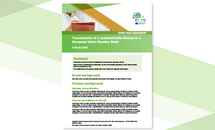Rapid Risk Assessment: Assessing SARS-CoV-2 circulation, variants of concern, non-pharmaceutical interventions and vaccine rollout in the EU/EEA, 16th update
Since its emergence in March 2021, the B.1.617.2 (Delta) variant of concern (VOC) has rapidly become predominant across the European Union/European Economic Area (EU/EEA). More than 99% of newly reported cases are attributed to this variant. The Delta variant has demonstrated a significant transmission advantage relative to previously circulating SARS-CoV-2 strains. However, full vaccination remains protective against severe outcomes such as hospitalisation, admission to intensive care and death. Currently available vaccines have played a crucial role in limiting viral circulation and in particular, limiting the impact of infections by the Delta variant.
Despite the fact that over 565 million vaccine doses have been administered in the EU/EEA so far, only 61.1% (range: 18.4–79.4%) of the total population in the EU/EEA have been fully vaccinated to date. The total population includes children and adolescents for whom the vaccine is not available or who may not be included in national target groups yet. There is considerable inter-country and sub-national variation in vaccine uptake, resulting in large proportions of the EU/EEA population remaining susceptible to SARS-CoV-2 infection.
Modelling scenarios that consider vaccination coverage, vaccine effectiveness, natural immunity and population contact rates—in the context of continued Delta circulation—indicate that the potential burden of disease risk in the EU/EEA from the Delta variant is high between now to the end of November, unless vaccination coverage can be increased rapidly in the total population in the next few weeks.
Executive Summary
Risk assessed in this update
The risk assessed in this update is as follows: based on current levels of vaccination coverage and the dominance of the Delta variant in the EU/EEA, what risk does SARS-CoV-2 pose to the general population and the vulnerable population in the coming months?
This update was prompted by the forecast modelling undertaken by ECDC and the planned relaxation of non-pharmaceutical and other measures announced by EU/EEA countries.
Our previous assessment published on 10 June 2021 (15th update) described the risk at that point in time, and classified EU/EEA countries based on SARS-CoV-2 transmission (expressed as low, moderate, high and very high concern). Here we assess the risk to broad groupings of EU/EEA countries based on their current and projected levels of vaccination coverage for the total population (low <45% total population; average 55-65% total population; high >75% total population). Through mathematical modelling, we forecast the disease burden between now and the end of November 2021. The assessment of risk posed by the SARS-CoV-2 pandemic is further stratified for the following groups in the total population: the vaccinated and the unvaccinated general population; the vaccinated and the unvaccinated vulnerable population. The assessment is based on the following elements: i) the vaccinated have a lower probability of infection and ii) a lower impact of such infection than the unvaccinated, while iii) the vulnerable population suffers a higher impact if infection occurs, when compared with the general population. Based on modelling projections, virus circulation and disease burden between now and end of November 2021, the following can be anticipated:
- Countries with COVID-19 vaccination coverage at or below the current EU average level in the total population and who are planning to relax non-pharmaceutical interventions (NPIs) have a high risk of experiencing a significant surge of cases, hospitalisations and mortality from now until the end of November 2021. In such a scenario, due to very high virus circulation, fully vaccinated vulnerable populations are also at risk of experiencing infection with a severe outcome.
- Countries with COVID-19 vaccination coverage above the current EU average level, and particularly those with the highest current coverage, in the total population have a lower, manageable risk of experiencing a severe surge of cases, hospitalisations and mortality from now until the end of November 2021, unless there is a rapid decline of vaccine effectiveness due to waning immunity.
Options for response
- Countries should continuously strive to increase their COVID-19 vaccination coverage in all eligible age groups, to limit the burden of infections posed by the Delta variant in the autumn. This requires continuous monitoring of vaccine uptake and associated social determinants to understand where and in which population groups and communities an immunity gap persists.
- According to the current ECDC forecast, depending on the local epidemiological and COVID-19 vaccination coverage situation, non-pharmaceutical interventions will still be needed between now and the end of November to control the circulation and impact of the Delta variant.
- Closing any COVID-19 vaccination gaps in vulnerable populations and healthcare workers before the winter months is also critical to mitigate the risks to healthcare systems, which may be impacted by influenza and other respiratory viruses, in addition to SARS-CoV-2, as the winter season approaches, posing the risk of further increasing the demand for care.
- To increase vaccination coverage, it will be key to address inequalities in access to COVID-19 vaccination in different population groups. It is also important to understand the factors that determine low vaccine uptake in some population groups, including issues around vaccine acceptance and access so that targeted, context-specific and effective interventions can be developed.
- Risk communication activities should clearly and consistently stress the important role that existing COVID-19 and influenza vaccines play in protecting people against severe disease. Messaging should also highlight the fact that although many countries have relaxed public health measures in recent months, maintaining hygiene measures and avoidance of unnecessary physical crowding remains prudent.
- Given the continuing risk of transmission among unvaccinated children, high levels of prevention and preparedness are required in the educational system.
- In addition to these response options, it remains crucial that COVID-19 surveillance systems are able to effectively monitor and report on COVID-19 cases, hospitalisations and deaths, in order to guide decisions on public health measures and to understand their impact. Vaccine effectiveness should also be monitored to inform vaccination programme strategies.
- Genomic sequencing of samples remains of high importance to characterise currently circulating variants, and to detect the emergence of novel variants with concerning characteristics.
What is new in this assessment?
- This Rapid Risk Assessment assesses the risk posed by the circulation of the Delta variant of SARS-CoV-2 from now until the end of November 2021, based on modelling scenarios and projected levels of vaccine coverage
- Updated data on seroprevalence and re-infection by SARS-CoV-2 are included, as well as available evidence on COVID-19 vaccine effectiveness, waning immunity and breakthrough infections.
- Information on vaccine hesitancy and good practice to approach hesitant populations and address misinformation are included, as well as risk communication advice and a list of proposed key messages.
Download
Read more
News story
High risk of autumn surge in COVID-19 cases and deaths in countries with insufficient vaccination coverage, warns ECDC
EU/EEA countries that have not yet achieved high enough COVID-19 vaccination coverage in their total populations, which are planning to relax non-pharmaceutical interventions during the next two weeks, run a high risk of experiencing a significant surge of cases, hospitalisations and mortality from now until the end of November.








